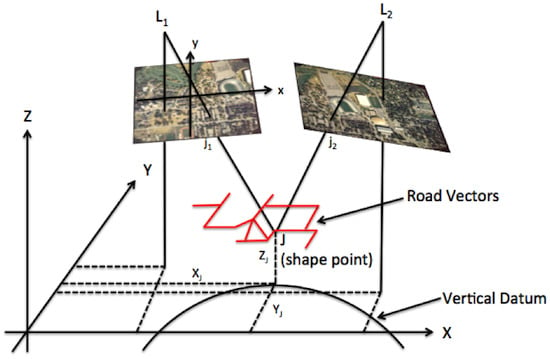A Photogrammetric Approach for Assessing Positional Accuracy of OpenStreetMap© Roads
Abstract
:1. Introduction
1.1. Motivation and Problem Statement
1.2. Proposed Solution
2. Background and Previous Work
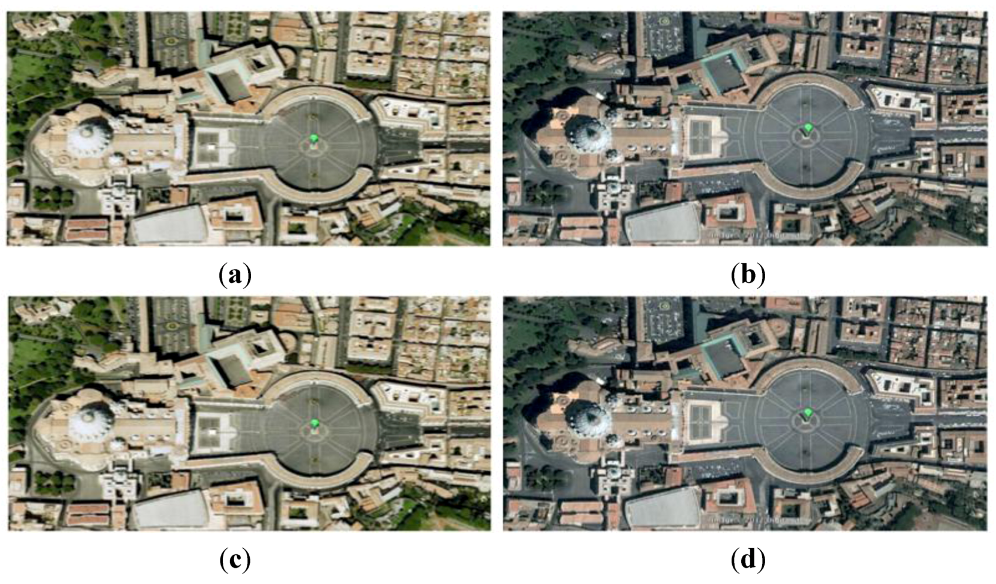
3. Methodology
3.1. Vector Adjustment Concept


 ,
,  ,
,  ), an object points image derived location (xj, yj), and the object point in ground space (XJ, YJ, ZJ) all lie on a single line is used to form the observation equations in the bundle adjustment.
), an object points image derived location (xj, yj), and the object point in ground space (XJ, YJ, ZJ) all lie on a single line is used to form the observation equations in the bundle adjustment. 3.2. Photogrammetric Bundle Adjustment
 ,
,  ,
,  ) of all the images. The EO parameters describe the exposure station coordinates (
) of all the images. The EO parameters describe the exposure station coordinates (  ,
,  ,
,  ) and the image orientation parameters (ω, ϕ, κ) that are used in the collinearity equations to formulate the image-to-ground relationship.
) and the image orientation parameters (ω, ϕ, κ) that are used in the collinearity equations to formulate the image-to-ground relationship.

 ,
,  and
and  are coordinates of the image exposure station; xo and yo are the coordinates of the principle point known from the camera calibration report; f is the focal length of the camera (also known from the camera calibration report); and
are coordinates of the image exposure station; xo and yo are the coordinates of the principle point known from the camera calibration report; f is the focal length of the camera (also known from the camera calibration report); and  ,
,  ,…,
,…,  are the rotation matrix terms formulated in Equation (4).
are the rotation matrix terms formulated in Equation (4). 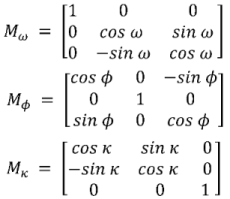


 is a matrix of partial derivatives of the observation equations with respect to the exterior image orientation parameters (ω, ϕ, κ,
is a matrix of partial derivatives of the observation equations with respect to the exterior image orientation parameters (ω, ϕ, κ,  ,
,  ,
,  );
);  is a vector of corrections to the exterior orientation parameters;
is a vector of corrections to the exterior orientation parameters;  is a matrix of partial derivatives of the observation equations with respect to the object point coordinates (XJ, YJ, ZJ);
is a matrix of partial derivatives of the observation equations with respect to the object point coordinates (XJ, YJ, ZJ);  is a vector of corrections to the object point coordinates (OSM shape points and GCP’s); εij is the misclosure vector which is used to minimize the sum of the squared residuals; Vij is the vector of residuals for the measured image coordinates. Adjustment residuals are important because they describe the difference between the measured and the adjusted values, which is a good indicator of how much the adjustment moved the input measurements as a result of the adjustment process.
is a vector of corrections to the object point coordinates (OSM shape points and GCP’s); εij is the misclosure vector which is used to minimize the sum of the squared residuals; Vij is the vector of residuals for the measured image coordinates. Adjustment residuals are important because they describe the difference between the measured and the adjusted values, which is a good indicator of how much the adjustment moved the input measurements as a result of the adjustment process. and
and  matrices are made up of terms resulting from linearizing the collinearity equations in [43].
matrices are made up of terms resulting from linearizing the collinearity equations in [43]. 
 matrix as:
matrix as:

 vector as:
vector as:

 vector as:
vector as:



 ,
,  and
and  are the measured coordinate value for point j; and
are the measured coordinate value for point j; and  ,
,  and
and  are the coordinate residuals for point j. To be consistent with the collinearity equations the object point observation equations will need to be evaluated at initial approximations as follows:
are the coordinate residuals for point j. To be consistent with the collinearity equations the object point observation equations will need to be evaluated at initial approximations as follows:

 ,
,  and
and  being the initial approximations for the coordinates of point j and dXj, dYj, dZj being the corrections to the approximations for coordinate point j, as solved for in the
being the initial approximations for the coordinates of point j and dXj, dYj, dZj being the corrections to the approximations for coordinate point j, as solved for in the  matrix. Since the collinearity equations are nonlinear an iterative approach is used where corrections to the parameters are solved for and applied each time through the loop until the difference in the correction is very small or essentially unchanged. This condition is referred to as convergence. Simplifying and expressing in matrix form yields:
matrix. Since the collinearity equations are nonlinear an iterative approach is used where corrections to the parameters are solved for and applied each time through the loop until the difference in the correction is very small or essentially unchanged. This condition is referred to as convergence. Simplifying and expressing in matrix form yields:

 being the difference between the current approximation and the initial approximation.
being the difference between the current approximation and the initial approximation. 
 being the residual for the object point j expressed in each component.
being the residual for the object point j expressed in each component. 

 is the a priori reference variance;
is the a priori reference variance;  ,
,  , and
, and  are the variances in
are the variances in  ,
,  , and
, and  , respectively; and the off diagonal terms are correlation coefficients. The final types of observations used in the bundle adjustment are the EO parameters. Their observation equations take on a form similar to the object points and are given as:
, respectively; and the off diagonal terms are correlation coefficients. The final types of observations used in the bundle adjustment are the EO parameters. Their observation equations take on a form similar to the object points and are given as:
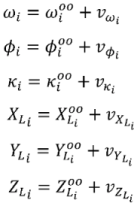
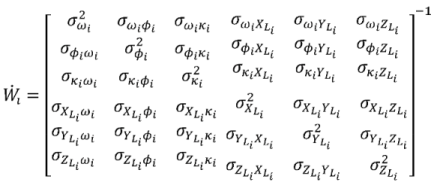

 is the a priori reference variance;
is the a priori reference variance;  and
and  are the variances in, xij and yij, respectively; and the covariance
are the variances in, xij and yij, respectively; and the covariance  =
=  are assumed to be uncorrelated. After the individual matrices for the observation equations are formed the full set of normal equations can be structured in matrix form as:
are assumed to be uncorrelated. After the individual matrices for the observation equations are formed the full set of normal equations can be structured in matrix form as:



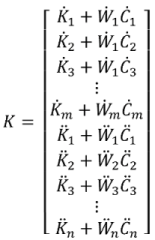







3.3. Adjustment Weighting
3.4. Absolute Accuracy
Root Mean Square Error (RMSE)


4. Experimental Results and Analysis
4.1. Project Datasets
4.2. OSM Urban City Streets Scenario
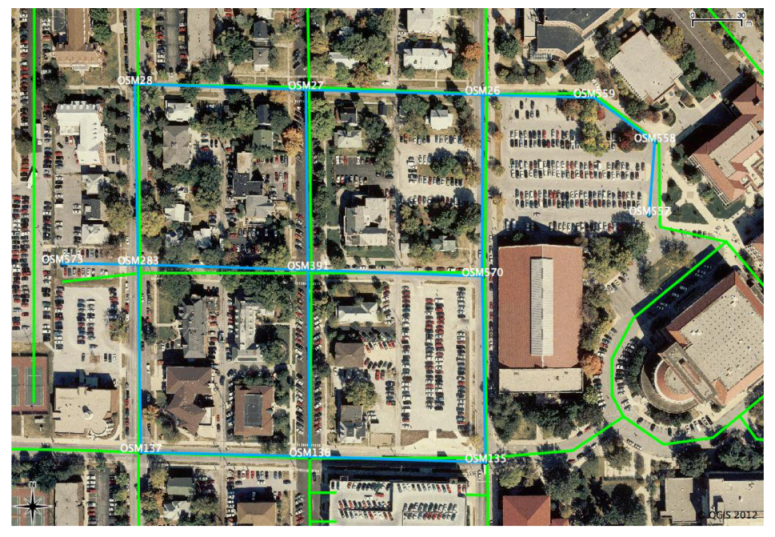
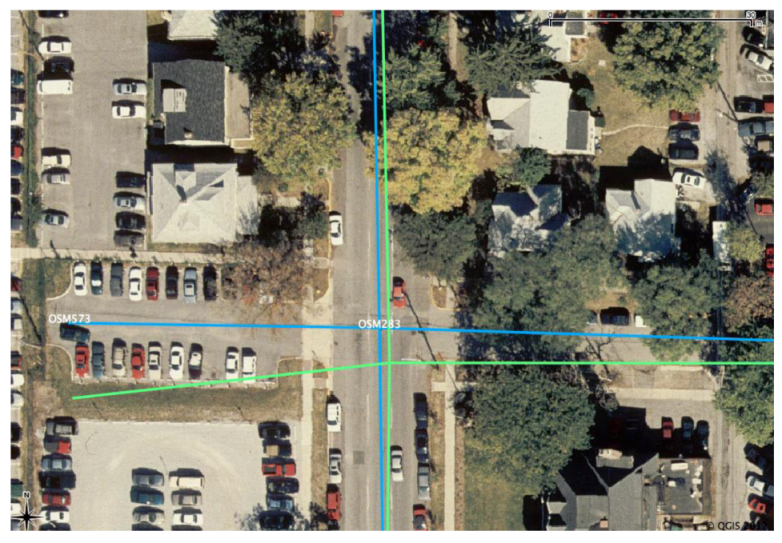
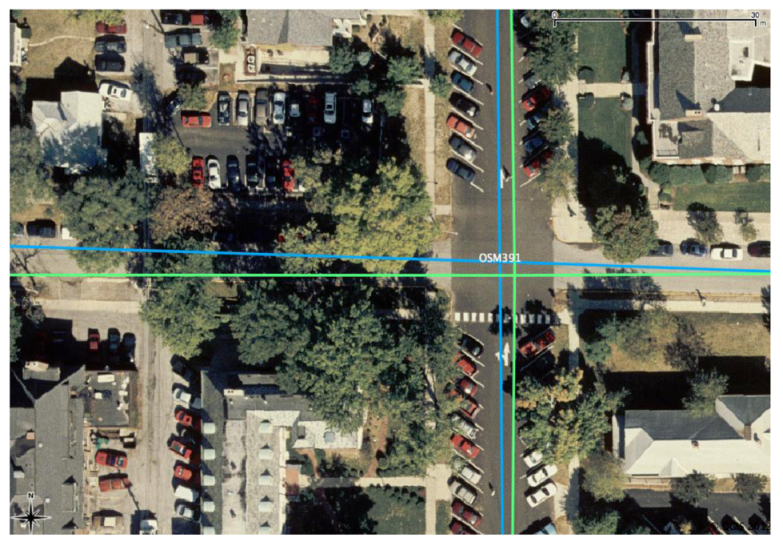
| PT. ID. | CE90 (m) | LE90 (m) | X (m) | Y (m) | Z (m) |
|---|---|---|---|---|---|
| OSM135 | 0.12 | 0.20 | 507,069.35 | 4,475,181.34 | 188.66 |
| OSM136 | 0.13 | 0.20 | 506,961.99 | 4,475,184.75 | 188.76 |
| OSM137 | 0.13 | 0.20 | 506,859.00 | 4,475,187.43 | 190.16 |
| OSM26 | 0.15 | 0.20 | 507,067.46 | 4,475,405.79 | 189.65 |
| OSM27 | 0.15 | 0.20 | 506,959.67 | 4,475,408.83 | 189.56 |
| OSM28 | 0.16 | 0.20 | 506,855.31 | 4,475,412.24 | 189.86 |
| OSM283 | 0.14 | 0.20 | 506,857.23 | 4,475,301.99 | 190.06 |
| OSM391 | 0.13 | 0.20 | 506,960.84 | 4,475,298.73 | 189.16 |
| OSM557 | 0.14 | 0.20 | 507,169.15 | 4,475,332.21 | 189.77 |
| OSM559 | 0.15 | 0.20 | 507,135.45 | 4,475,403.94 | 189.87 |
| OSM570 | 0.13 | 0.20 | 507,067.27 | 4,475,294.90 | 189.16 |
| OSM573 | 0.15 | 0.20 | 506,810.98 | 4,475,302.72 | 190.36 |
| PT. ID. | Vx (m) | Vy (m) | Vz (m) |
|---|---|---|---|
| OSM135 | −0.76 | −2.61 | 0.00 |
| OSM136 | −0.17 | 1.08 | 0.01 |
| OSM137 | 1.55 | 0.21 | 0.00 |
| OSM26 | −2.74 | −0.20 | 0.00 |
| OSM27 | −1.96 | −1.46 | 0.00 |
| OSM28 | −1.90 | 0.18 | 0.01 |
| OSM283 | −1.55 | 5.20 | 0.01 |
| OSM391 | −2.22 | 2.03 | 0.00 |
| OSM557 | −6.67 | 7.26 | 0.00 |
| OSM559 | 0.56 | −2.71 | 0.00 |
| OSM570 | −1.52 | −2.42 | 0.00 |
| OSM573 | −0.65 | 11.19 | 0.01 |
| RMSE | 5.04 |
| PT. ID. | Un-Adjusted | Adjusted | ||||
|---|---|---|---|---|---|---|
| ΔX (m) | ΔY (m) | ΔZ (m) | ΔX (m) | ΔY (m) | ΔZ (m) | |
| OSM135 | 1.26 | 2.45 | 0.19 | 0.51 | −0.16 | 0.19 |
| OSM136 | 0.70 | −0.74 | 0.03 | 0.53 | 0.34 | 0.04 |
| OSM137 | −0.46 | −0.31 | 0.01 | 1.09 | −0.10 | 0.01 |
| OSM26 | 3.05 | 0.14 | 0.12 | 0.31 | −0.06 | 0.12 |
| OSM27 | 1.90 | 1.65 | 0.08 | −0.06 | 0.19 | 0.08 |
| OSM28 | 0.69 | 0.06 | 0.05 | −1.21 | 0.24 | 0.05 |
| OSM283 | 1.53 | −4.79 | 0.09 | 0.02 | 0.41 | 0.09 |
| OSM391 | 1.94 | −1.93 | 0.07 | −0.28 | 0.10 | 0.07 |
| OSM557 | 6.31 | −6.34 | 0.23 | −0.36 | 0.92 | 0.22 |
| OSM559 | −1.18 | 3.07 | 0.29 | −0.61 | 0.36 | 0.28 |
| OSM570 | 1.03 | 2.08 | 0.30 | −0.49 | −0.33 | 0.30 |
| OSM573 | 0.35 | −11.09 | 0.27 | −0.30 | 0.09 | 0.28 |
| RMSE | 4.81 | RMSE | 0.69 | |||
| PT. ID. | ΔX (m) | ΔY (m) | ΔZ (m) |
|---|---|---|---|
| CKPT1 | −0.01 | 0 | 0 |
| CKPT2 | −0.12 | 0.08 | −0.12 |
| CKPT3 | 0.06 | −0.02 | 0.03 |
| CKPT4 | 0.15 | −0.27 | 0.08 |
| CKPT5 | −0.08 | 0.03 | −0.08 |
| CKPT6 | −0.09 | 0.02 | 0.06 |
| RMSE | 0.15 |
4.3. Feature Attributes
| Attribute | Value (m) |
|---|---|
| Type | Shape Point |
| ID | OSM391 |
| X | 506,963.06 |
| Y | 4,475,296.70 |
| Vx | −2.20 |
| Vy | 2.04 |
| Adj. X | 506,960.86 |
| Adj. Y | 4,475,298.74 |
| Adj. Z | 189.17 |
| CE90 | 0.13 |
| LE90 | 0.20 |
4.4. Head-to-Head Accuracy Assessment of OSM, TNM, and TIGER 07 Roads

| PT. ID. | OSM | TNM | TIGER 07 | |||
|---|---|---|---|---|---|---|
| Vx (m) | Vy (m) | Vx (m) | Vy (m) | Vx (m) | Vy (m) | |
| OSM135 | −0.75 | −2.63 | 2.34 | 1.22 | −12.74 | 11.15 |
| OSM136 | −0.17 | 1.08 | 0.18 | 1.39 | −18.31 | 14.71 |
| OSM137 | 1.55 | 0.23 | 0.98 | 0.87 | −17.78 | 17.51 |
| OSM26 | −2.70 | −0.20 | 1.34 | −0.07 | −14.39 | 2.54 |
| OSM27 | −1.91 | −1.45 | −0.52 | 0.15 | −20.37 | 5.68 |
| OSM28 | −1.86 | 0.20 | −1.22 | 1.22 | −22.94 | 9.24 |
| OSM283 | −1.52 | 5.22 | −0.16 | 1.57 | −19.61 | 7.21 |
| OSM391 | −2.20 | 2.04 | −0.03 | 0.77 | −19.32 | 6.61 |
| OSM559 | 0.61 | −2.72 | 5.81 | 1.29 | −10.06 | 2.11 |
| OSM570 | −1.50 | −2.42 | 0.67 | 0.20 | −14.69 | 2.65 |
| OSM573 | −0.63 | 11.22 | −0.61 | 6.09 | −0.63 | 11.20 |
| RMSE | 4.35 | 2.89 | 19.17 | |||
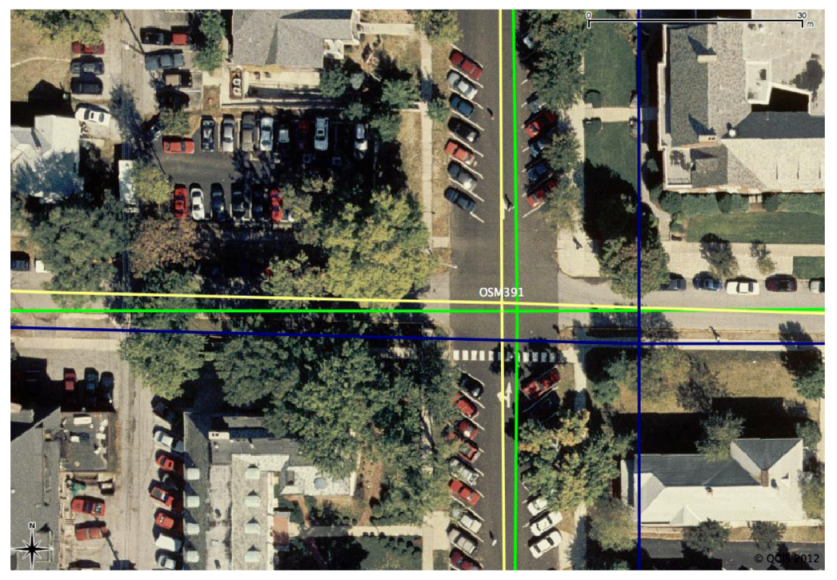
5. Conclusions and Future Work
5.1. Conclusions
5.2. Future Work and Recommendations
References
- OpenStreetMap© Online Documentation Wiki. Available online: http://wiki.openstreetmap.org/wiki/About (accessed on 7 August 2012).
- Goodchild, M.F. Geographic information science. Int. J. Geogr. Inf. Syst. 1992, 6, 31–45. [Google Scholar] [CrossRef]
- Ferris State University Surveying/Engineering Course Work. Available online: http://www.ferris.edu/HTMLS/colleges/cot/surveying/CheckSheets/SureCheckSheetBS.htm (accessed on 1 December 2012).
- Thompson, M. Maps for America: Cartographic Products of the U.S. Geological Survey and Others; US Dept. of Interior, Geological Survey: Washington, DC, USA, 1988. [Google Scholar]
- American Congress on Surveying and Mapping (ACSM). The proposed standard for digital cartographic data. Am. Cartogr. 1988, 15, 9–140. [Google Scholar] [CrossRef]
- ASPRS Accuracy Standards for Large-Scale Maps; American Society of Photogrammetry and Remote Sensing (ASPRS): Bethesda, MD, USA, 1990; p. 1069.
- CloudMade Online Documentation. Available online: http://cloudmade.com/about (accessed on 7 November 2012).
- Tech Crunch Online News Article. Available online: http://techcrunch.com/2012/05/04/apple-finally-gives-proper-credit-to-openstreetmap-in-iphoto-for-ios/ (accessed on 7 November 2012).
- Ushahidi Online Wiki Documentation. Available online: http://en.wikipedia.org/wiki/Ushahidi (accessed on 7 November 2012).
- OpenStreetMap© Online Mapping Project Database. Available online: http://www.openstreetmap.org/ (accessed on 11 December 2011).
- US Geological Survey National Map Database. Available online: http://viewer.nationalmap.gov/viewer/ (accessed on 2 July 2012).
- US Census Bureau Topologically Integrated Geographic Encoding Referencing (TIGER) 2007 Shapefiles Database. Available online: http://www.census.gov/cgi-bin/geo/shapefiles/national-files (accessed on 2 July 2012).
- Goodchild, M.F.; Hunter, G. A simple positional accuracy measure for linear features. Int. J. Geogr. Inf. Sci. 1997, 11, 299–306. [Google Scholar] [CrossRef]
- Kiiveri, H. Assessing, representing, and transmitting positional uncertainty in maps. Int. J. Geogr. Inf. Sci. 1997, 11, 33–52. [Google Scholar] [CrossRef]
- US Dept. of Interior. A Study of Land Information; US Department of Interior: Washington, DC, USA, 1990; pp. 100–409. [Google Scholar]
- Stanislawski, L.; Dewitt, B.; Shrestha, L. Estimating positional accuracy of data layers within a GIS through error propagation. Photogramm. Eng. Remote Sensing 1996, 62, 429–433. [Google Scholar]
- Heuvelink, G.; Burrough, P. Developments in statistical approaches to spatial uncertainty and its propagation. Int. J. Geogr. Inf. Sci. 2002, 16, 111–113. [Google Scholar] [CrossRef]
- Doucette, P.; Motsko, D.; Sorenson, M.; White, D. Uncertainty Handling in Geospatial Data. In Proceedings of SPIE 2012 Defense, Security, and Sensing Symposium, Baltimore, MD, USA, 23–27 April 2012.
- Lee, B. Spatial pattern of uncertainties: An accuracy assessment of the TIGER files. J. Geogr. Geol. 2009, 1, 2–12. [Google Scholar]
- Zent, C.J. TIGER vs. DLG Road Feature Data. M.Sc. Thesis, The State University of New York at Buffalo, New York, NY, USA, 1996. [Google Scholar]
- Haklay, M. How many volunteers does it take to map an area well? The validity of Linus’ Law to volunteered geographic information. Cartogr. J. 2008, 47, 315–322. [Google Scholar] [CrossRef]
- Zielstra, D.; Zipf, A. A Comparative Study of Proprietary Geodata and Volunteered Geographic Information for Germany. In Proceedings of 13th Agile International Conference on Geographical Information Science 2010, Guimaraes, Portugal, 11–14 May 2010.
- Cipeluch, B.; Jacobs, R.; Winstanley, A. Comparison of the Accuracy of OpenStreetMap for Ireland with Google Maps and Bing Maps. In Proceedings of the Spatial Accuracy Symposium, Leicester, UK, 20–23 July 2010.
- O’Grady, K. A DOQ Test Project: Collecting Data to Improve TIGER. Available online: http://www.census.gov/geo/mod/esri_paper.pdf (accessed on 11 February 2012).
- Liadis, J. GPS TIGER Accuracy Analysis Tools (GTAAT) Evaluation and Test Results. Available online: http://www.census.gov/geo/www/tiger/gtaat2000.pdf (accessed on 11 February 2012).
- Zandbergen, P.; Lenzer, K.; Ignizio, D. Positional accuracy of TIGER 2000 and 2009 road networks. Trans. GIS 2011, 15, 495–519. [Google Scholar] [CrossRef]
- Haklay, M. How good is volunteered geographical information? A comparative study of OpenStreetMap and Ordnance Survey datasets. Environ. Plan. B 2010, 37, 682–703. [Google Scholar] [CrossRef]
- GeoEye, Inc. GeoEye Product Specifications. Available online: http://www.geoeye.com/CorpSite/products-and-services/imagery-collection/satellite-imagery-products/product-specifications.aspx (accessed on 23 February 2012).
- Talaya, J.; Kornus, W.; Alamus, R.; Soler, E.; Pla, M.; Ruiz, A. Analyzing DMC Performance in a Production Environment. In Proceedings of the 37th ISPRS Congress, Beijing, China, 3–11 July 2008.
- Google Earth Geo Viewer (v.6.1)-Imagery Archive 2012; Google Inc.: Mountain View, CA, USA, 2007.
- Burrough, P.A. GIS and geostatistics: Essential partners for spatial analysis. Environ Ecol. Stat. 2001, 8, 361–377. [Google Scholar] [CrossRef]
- Goodchild, M.F. Towards Models of Error for Categorical Maps. In Proceedings of First Specialist Meeting on Accuracy of Spatial Data Bases, National Center for Geographical Information and Analysis, Montecito, CA, USA, 13–16 December 1988.
- Goodchild, M.F.; Gopal, S. Modelling Error in Objects and Fields. Accuracy of Spatial Databases; Taylor & Francis: New York, NY, USA, 1989; pp. 107–114. [Google Scholar]
- Heuvelink, G.; Burrough, P.; Stein, A. Propagation of errors in spatial modelling with GIS. Int. J. Geogr. Inf. Syst. 1989, 3, 303–322. [Google Scholar] [CrossRef]
- Veregin, H. Accuracy of Spatial Databases: Annotated Bibliography; Technical Paper 89-9; NCGIA: Santa Barbara, CA, USA, 1989. [Google Scholar]
- Veregin, H. A Taxonomy of Error in Spatial Databases; Technical Paper 89-12; NCGIA: Santa Barbara, CA, USA, 1989. [Google Scholar]
- Goodchild, M.F. Keynote Address. In Proceedings of Symposium on Spatial Database Accuracy, Melbourne, Australia, 19–20 June 1991; pp. 1–6.
- Shi, W.; Tempfli, K.; Ehlers, M. Analytical modelling of positional and thematic uncertainties in the integration of remote sensing and geographical information systems. Trans. GIS 1999, 3, 119–136. [Google Scholar]
- Shi, W.; Liu, W. A stochastic process-based model for the positional error of line segments in GIS. Geogr. Inf. Sci. 2000, 14, 51–66. [Google Scholar] [CrossRef]
- Love, K.; Ye, K.; Smith, E.; Prisley, S. Error Models in Geographic Information Systems Vector Data using Bayesian Methods; Technical Report for the National Geospatial-Intelligence Agency (NGA); NGA-US Government: Springfield, VA, USA, 2007. [Google Scholar]
- US Geological Survey. National Elevation Dataset Online Database. Available online: http://ned.usgs.gov/ (accessed on 8 December 2011).
- Mikhail, E.; Bethel, J.; McGlone, J.C. Introduction to Modern Photogrammetry; John Wiley & Sons: New York, NY, USA, 2001. [Google Scholar]
- Wolf, P.; Dewitt, B. Elements of Photogrammetry with Applications in GIS, 3rd ed; McGraw-Hill Publishing Company: Madison, WI, USA, 2000. [Google Scholar]
- Andersen, J.; Mikhail, E. Surveying Theory and Practice, 7th ed; McGraw Hill Publishers: New York, NY, USA, 1998; p. 31. [Google Scholar]
- Ager, T.P. An Analysis of Metric Accuracy Definitions and Methods of Computation; InnoVision Whitepaper; National Imaging and Mapping Agency (NIMA): Springfield, VA, USA, 2002. [Google Scholar]
- Canavosio-Zuzelski, R. A Photogrammetric Approach for Geopositioning OpenStreetMap Roads. Ph.D. Thesis, George Mason University, Fairfax, VA, USA, 2013. [Google Scholar]
- Iiyama, M.; Dolloff, J.; Taylor, C. The ABC’s of RSM: An Introduction to the Replacement Sensor Model; Technical Report; BAE Systems, Inc.: Aberdeen, SD, USA, 2006. [Google Scholar]
© 2013 by the authors; licensee MDPI, Basel, Switzerland. This article is an open access article distributed under the terms and conditions of the Creative Commons Attribution license (http://creativecommons.org/licenses/by/3.0/).
Share and Cite
Canavosio-Zuzelski, R.; Agouris, P.; Doucette, P. A Photogrammetric Approach for Assessing Positional Accuracy of OpenStreetMap© Roads. ISPRS Int. J. Geo-Inf. 2013, 2, 276-301. https://doi.org/10.3390/ijgi2020276
Canavosio-Zuzelski R, Agouris P, Doucette P. A Photogrammetric Approach for Assessing Positional Accuracy of OpenStreetMap© Roads. ISPRS International Journal of Geo-Information. 2013; 2(2):276-301. https://doi.org/10.3390/ijgi2020276
Chicago/Turabian StyleCanavosio-Zuzelski, Roberto, Peggy Agouris, and Peter Doucette. 2013. "A Photogrammetric Approach for Assessing Positional Accuracy of OpenStreetMap© Roads" ISPRS International Journal of Geo-Information 2, no. 2: 276-301. https://doi.org/10.3390/ijgi2020276
APA StyleCanavosio-Zuzelski, R., Agouris, P., & Doucette, P. (2013). A Photogrammetric Approach for Assessing Positional Accuracy of OpenStreetMap© Roads. ISPRS International Journal of Geo-Information, 2(2), 276-301. https://doi.org/10.3390/ijgi2020276



